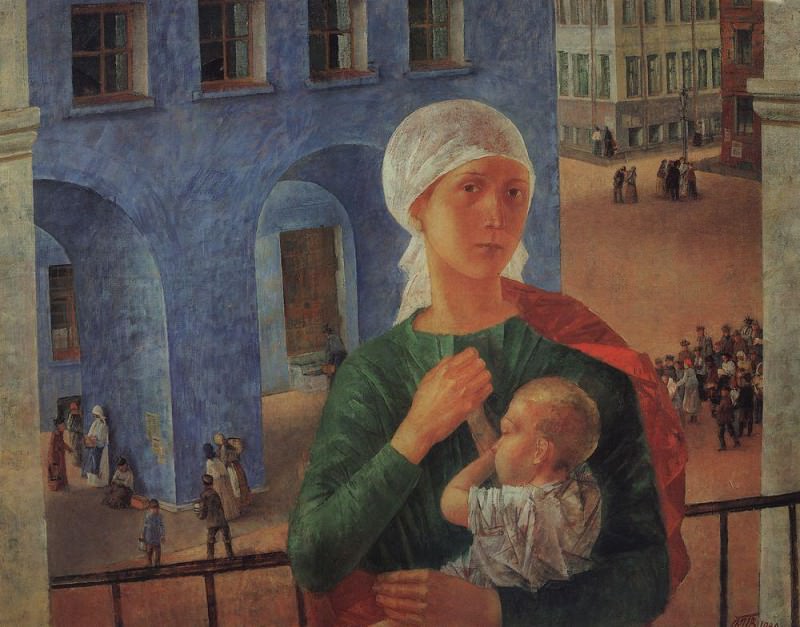1918 in Petrograd. 1920 Kuzma Sergeevich Petrov-Vodkin (1878-1939)
Kuzma Sergeevich Petrov-Vodkin – 1918 in Petrograd. 1920
Edit attribution
Download full size: 1000×783 px (0,1 Mb)
Painter: Kuzma Sergeevich Petrov-Vodkin
Location: The State Tretyakov Gallery, Moscow (Государственная Третьяковская галерея).
This painting by Kuzma Petrov-Vodkin is often called the "Petrograd Madonna." And those who so dubbed it are right, because the nursing mother with the baby, standing on the balcony of the city house, even in her facial expression resembles an iconic image. The woman’s hair is hidden under a white shawl, and a scarlet cloth is thrown over her shoulder, a peculiar symbol of revolution. The young mother has a tired and at the same time stern look.
Description of Kuzma Petrov Vodkin’s painting In Petrograd
This painting by Kuzma Petrov-Vodkin is often called the "Petrograd Madonna." And those who so dubbed it are right, because the nursing mother with the baby, standing on the balcony of the city house, even in her facial expression resembles an iconic image.
The woman’s hair is hidden under a white shawl, and a scarlet cloth is thrown over her shoulder, a peculiar symbol of revolution. The young mother has a tired and at the same time stern look. But still some ray of hope for a bright future in it. And it is symbolized by the sky-blue building behind the lady.
The glass in this house looks strange. They are either broken in places, or covered with cobwebs, or maybe just covered with dust. This house has probably been abandoned by a wealthy family, and the common people haven’t moved in yet.
The streets are rather deserted, except for the crowds of people, which critics have posited as a queue for bread, epitomizing the time of hunger. But neither the bread nor the vendor is visible to the viewer: everything is concealed by the figure of the mother, who does not care about what is going on below. All of this is transient, the main thing for her is to raise her child.
Some people see this baby as a symbol of the emerging Soviet country, while others see the image of mother as a symbol of Russia. That is, we can say that it is no longer an icon of the Mother of God, but it is still not the image of Motherland, which began to be exploited on a mass scale somewhat later. It was particularly often referred to in the days of the Great Patriotic War and after it.
The idea of the canvas "1918 in Petrograd" - this is the official title of the painting - can be expressed as follows: there will be no devastation and poverty, we will be able to overcome it. Motherhood is the brightest symbol of continued life, it is like a seed that has sprouted among the stone walls of starving Petrograd.
Кому понравилось
Пожалуйста, подождите
На эту операцию может потребоваться несколько секунд.
Информация появится в новом окне,
если открытие новых окон не запрещено в настройках вашего браузера.
You need to login
Для работы с коллекциями – пожалуйста, войдите в аккаунт (open in new window).


















COMMENTS: 2 Ответы
Прекрасная картина!!!!
Я старался!
You cannot comment Why?
The background contrasts the intimate scene of motherhood with the chaotic public life. The blue building features arched entrances with small groups of figures, suggesting a sense of confinement or hardship. In the distance, a street is filled with a crowd of people, appearing to be moving purposefully but also in a somewhat disorganized manner. The overall atmosphere is somber and reflects the tumultuous times of 1918 in Petrograd, a period marked by revolution and civil war in Russia.
The subtext of the painting likely revolves around themes of resilience, hope, and the enduring nature of maternal love amidst societal upheaval. The juxtaposition of the nurturing mother and child with the turbulent external environment could symbolize the struggle for survival and the perpetuation of life in the face of adversity. The womans upward gaze might represent a plea for a better future or a quiet defiance against the surrounding chaos. The painting evokes a sense of both vulnerability and strength, highlighting the vital role of women and family in preserving humanity during times of crisis.